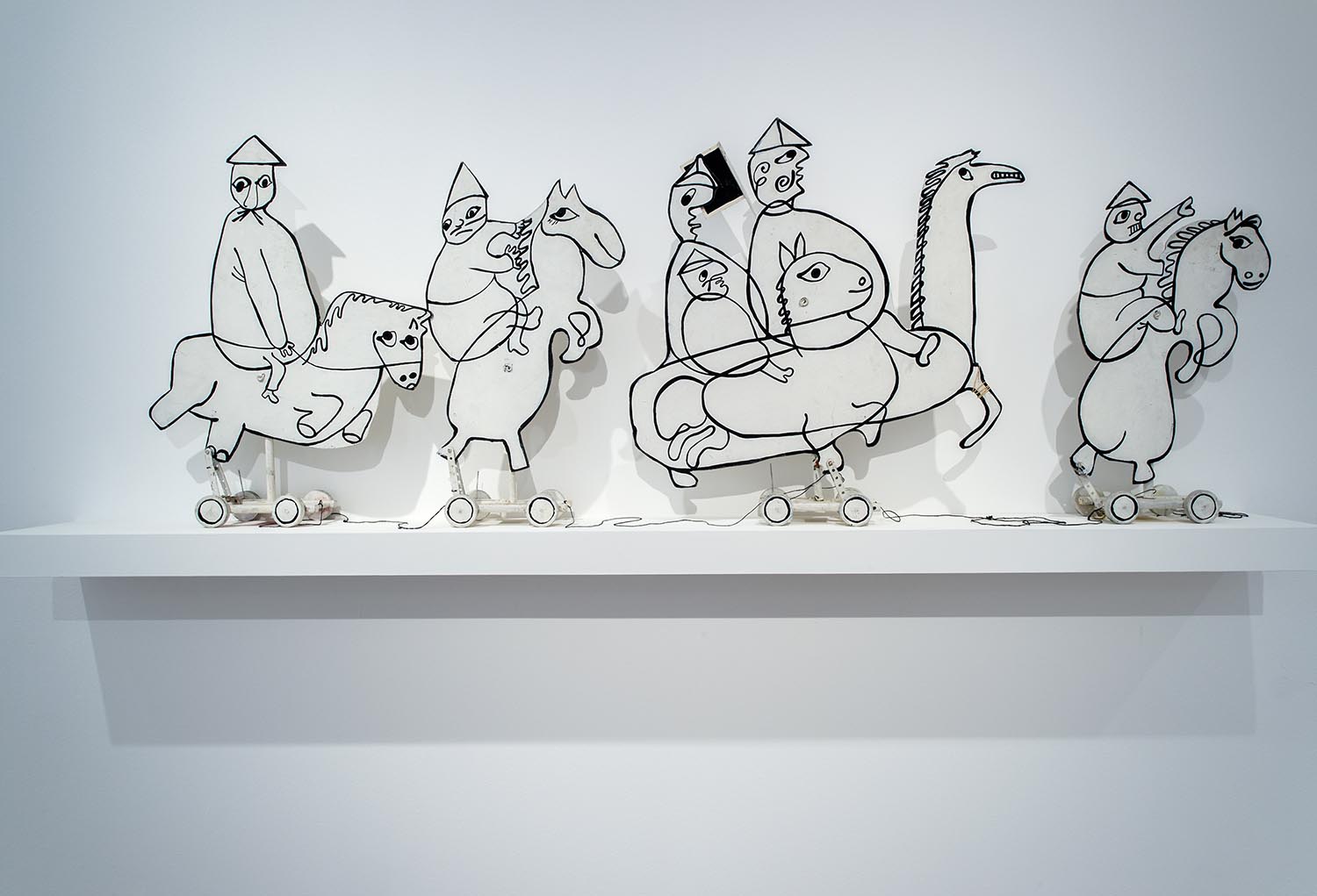


Puppets by Franciszka Themerson for KUNG UBU, Marionetteatern, Stockholm, 1964 Photo: Valerie Bennett
Back in London this week, and taking advantage of the – briefly – sunny days to take a trip to Camden Arts Centre. On display until the beginning of June are a brilliantly complementary pair of exhibitions featuring artists with a shared love of language.
In Gallery 3 Karl Holmqvist has inhabited the space with witty concrete poetry, palindromes painted directly on to the walls, on canvases and in works on paper. Born in Sweden and now resident in Berlin the artist also spent time in New York in the late 80s and early 90s. Holmqvist has had a lifelong interest in language as the most democratic of media: all you need is a pencil and paper, and if you can’t afford paper, you can write on the wall. Here at Camden he is showing works from the last two years, with the addition of a leporello FACEHUG #1 from 2007 and his video collage OUR HOUSE from the same year. The installation has an energising dynamism, accentuated by the addition of works that respond to the site, such as the wall text that reads “London Traffick” between the windows that look out over the roaring Finchley Road.
The main galleries are devoted to an extensive exhibition of work by the Polish émigré couple Franciszka and Stefan Themerson. It is a wonderful opportunity to get acquainted with work by artists whose biography alone is worthy of a movie for the way it refracts European history of the 20th century. Stefan was born in Płock, then part of the Russian empire, in 1910. By the late 20s he was studying physics at the university in Warsaw, but spending most of his time experimenting with photography, collage and film making. In 1929 he met Franciszka and by 1931 they were married. Together they made five experimental films in the years up to 1935, and by 1936 were lured to Paris by the ferment of avant-garde activity there. They moved to Paris full-time in 1938 and in 1939 at the outbreak of WWII both enlisted. Franciszka worked with the Polish army in exile, first in Paris and then in London. Stefan joined a Polish infantry regiment, and when that disbanded in chaos after the invasion of France, spent the next two years in various refugee camps, or working as a farm labourer, until Franciszka’s efforts made it possible for the RAF to fly him from Lisbon to safety in London. Reunited with Franciszka, they moved in 1944 to Maida Vale.
Together the Themersons founded the Gaberbocchus Press (the name based on Lewis Carroll’s Jabberwocky) and published works by Guillaume Apollinaire, Kurt Schwitters and the first English translation of Alfred Jarry’s proto-surrealist masterpiece Ubu Roi. The publications were illustrated with Franciszka’s distinctive, drawings which were also the focus of the work The Good Citizen’s Alphabet which they published with Bertrand Russell in 1953.
In 1952, Franciszka created masks for a dramatised reading of Ubu Roi at the ICA in London; she designed the stage production with life-size puppets for the Marionetteatern of Stockholm in 1964, and finally drew her own comic-strip version of Ubu in 1969. Some of the masks and the comic strip are beautifully presented in the exhibition at Camden, along with larger scale works based on the play. All the while Stefan continued to make photograms, and together they made two further films both of which are presented in the current exhibition. Calling Mr Smith was made in 1943. It is an emotional plea to the British people to take consciousness of the atrocities being committed in Europe by the Nazi regime. Bitterly situating the Nazis as the culmination of German culture in the 20th century, the film collages photography and text with footage of the starving and the dead as well as marching columns of Hitler youth.
The Eye and the Ear, 1944, is ostensibly a more formalist film, subdivided in to four sections each based on a song by the Polish composer Szymanowski. A female voice, very British and very of the time, introduces each section and describes the various approaches to graphically rendering the music: geometric forms combine with found images with such sophistication that in this age of post-internet art, you are sent back to check with wonder at the date of the piece. The last of the four sections is a song called Wanda, lyrical and mesmerising it features overlapping ripples on water. But more than an exercise in synesthetic combination of music and image, it refers to the legend of an 8th century Polish queen who drowned herself rather than be married to a German princeling: the political symbolism is overwhelming. Thanks to the wonder of the internet, if you can’t get to Camden, you can see these extraordinary films here:
Stefan and Franciszka died within weeks of each other in London in 1988. Their story is woven tightly into the social, political and intellectual history of Europe, their friends included not only Schwitters and Russell but also British performance poet Bob Cobbing, who was a neighbour. This insight into recent history seems somehow all the more important, as we run up to the referendum on 23 June.
Caroline Douglas
Director
Karl Holmqvist, READ DEAR, and Franciszka & Stefan Themerson, Books, Camera, Ubu
Camden Arts Centre, Arkwright Road, London NW3 6DG. Open Tuesday - Sunday 10.00 - 18.00, Wednesday 10.00 - 21.00. Exhibition continues until 5 June 2016.
www.camdenartscentre.org